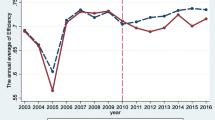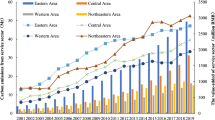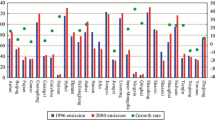Abstract
The essential to achieving the 2060 carbon neutrality target in China lies in the performance of the construction industry. Decoupling economic development from CO2 emissions is the main strategy for reducing emissions in the construction industry. This paper is based on panel data for China and its 30 provinces during 2009–2019. A Tapio decoupling model is constructed to analyze the decoupling state of economic development and CO2 emissions in the construction industry. The logarithmic mean Divisia index model is constructed to continue the decomposition of the drivers of the decoupling state and CO2 emissions. The results show that (1) the economic development level of most provinces is positively correlated with their CO2 emissions; (2) Beijing and Jiangsu reach the ideal strong decoupling state, and Heilongjiang has the worst decoupling state. The same type of decoupling state shows a certain aggregation phenomenon in space; (3) economic output plays a critical role in promoting CO2 emissions and decoupling of the construction industry in China and the provinces. The main driver of decoupling is indirect carbon intensity; (4) energy intensity has a greater impact on CO2 emissions reduction in regions with more developed economic levels. Understanding the drivers of the decoupling state in China’s construction industry provides a valuable basis for energy efficiency and emission reduction efforts in China and other countries.






Similar content being viewed by others
Data availability
The datasets used and/or analyzed during the current study are available from the corresponding author on reasonable request.
References
Ahmad M, Jabeen G, Irfan M et al (2021) Do inward foreign direct investment and economic development improve local environmental quality: aggregation bias puzzle. Environ Sci Pollut Res 28(26):34676–34696. https://doi.org/10.1007/s11356-021-12734-y
Ahmad M, Zhao ZY, Li H (2019) Revealing stylized empirical interactions among construction sector, urbanization, energy consumption, economic growth and CO2 emissions in China. Sci Total Environ 657:1085–1098. https://doi.org/10.1016/j.scitotenv.2018.12.112
Ang BW (2004) Decomposition analysis for policymaking in energy. Energy Policy 32(9):1131–1139. https://doi.org/10.1016/s0301-4215(03)00076-4
Ang BW (2005) The LMDI approach to decomposition analysis: a practical guide. Energy Policy 33(7):867–871. https://doi.org/10.1016/j.enpol.2003.10.010
Ahmet AS, Durakbasa NM (2012) Evaluation of corporate energy management practices of energy intensive industries in Turkey. Energy 45(1):81–91. https://doi.org/10.1016/j.energy.2012.03.032
Ang BW, Choi K-H (1997) Decomposition of aggregate energy and gas emission intensities for industry: a refined Divisia index method. Energy J 18(3):59–73
Bibi F, Jamil M (2021) Testing environment Kuznets curve (EKC) hypothesis in different regions. Environ Sci Pollut Res 28(11):13581–13594. https://doi.org/10.1007/s11356-020-11516-2
Chen JD, Shen LY, Song XN et al (2017) An empirical study on the CO2 emissions in the Chinese construction industry. J Clean Prod 168:645–654. https://doi.org/10.1016/j.jclepro.2017.09.072
Cui E, Ren L, Sun H (2016) Analysis of energy-related CO2 emissions and driving factors in five major energy consumption sectors in China. Environ Sci Pollut Res Int 23(19):19667–19674. https://doi.org/10.1007/s11356-016-7081-7
Dong B, Ma X, Zhang Z et al (2020) Carbon emissions, the industrial structure and economic growth: evidence from heterogeneous industries in China. Environ Pollut 262:114322. https://doi.org/10.1016/j.envpol.2020.114322
Du Q, Zhou J, Pan T et al (2019a) Relationship of carbon emissions and economic growth in China’s construction industry. J Clean Prod 220:99–109. https://doi.org/10.1016/j.jclepro.2019.02.123
Du Q, Lu XR, Yu M et al (2020) Low-carbon development of the construction industry in China’s pilot provinces. Pol J Environ Stud 29(4):2617–2629. https://doi.org/10.15244/pjoes/111969
Du Q, Shao L, Zhou J, et al (2019b) Dynamics and scenarios of carbon emissions in China’s construction industry. Sustain Cities Soc 48. https://doi.org/10.1016/j.scs.2019b.101556
Enevoldsen MK, Ryelund AV, Skou AM (2007) Decoupling of industrial energy consumption and CO2-emissions in energy-intensive industries in Scandinavia. Energy Economics 29(4):665–692. https://doi.org/10.1016/j.eneco.2007.01.016
Fan JL, Cao Z, Zhang X et al (2019) Comparative study on the influence of final use structure on carbon emissions in the Beijing-Tianjin-Hebei region. Sci Total Environ 668:271–282. https://doi.org/10.1016/j.scitotenv.2019.02.363
Feng B (2015) Research on carbon decoupling effect and influence factors of provincial construction industry in China. China Popul Resour Environ 25(04):28–34
Standing Committee of the 12 People's Congress of Jiangsu Province (2015) Regulations of Jiangsu Province on development of green buildings. https://zhidao.baidu.com/question/528461541981661485.html. Accessed 27 March 2015
Guo S, Yan D, Hu S, et al (2021) Modelling building energy consumption in China under different future scenarios. Energy 214. https://doi.org/10.1016/j.energy.2020.119063
He JH, Yue Q, Li Y, et al (2020) Driving force analysis of carbon emissions in China’s building industry: 2000-2015. Sustain Cities Soc 60.https://doi.org/10.1016/j.scs.2020.102268
Huang YH, Wu JH, Huang HS (2021) Analyzing the driving forces behind CO2 emissions in energy-resource-poor and fossil-fuel-centered economies: case studies from Taiwan, Japan, and South Korea. Energies, 14(17). https://doi.org/10.3390/en14175351
IPCC (2006) Guidelines for national greenhouse gas inventories. https://www.ipcc-nggip.iges.or.jp/public/2006gl/index.html
IPCC (2007) IPCC fourth assessment report: climate change. https://www.ipcc.ch/report/ar4/syr/. Accessed Sept 2016
Iqbal M, Ma J, Ahmad N et al (2021) Promoting sustainable construction through energy-efficient technologies: an analysis of promotional strategies using interpretive structural modeling. Int J Environ Sci Technol 18(11):3479–3502. https://doi.org/10.1007/s13762-020-03082-4
Jia ZJ, Lin BQ (2021) How to achieve the first step of the carbon-neutrality 2060 target in China: the coal substitution perspective. Energy 233. https://doi.org/10.1016/j.energy.2021.121179
Jiang R, Li R (2017) Decomposition and decoupling analysis of life-cycle carbon emission in China’s building sector. Sustainability 9(5). https://doi.org/10.3390/su9050793
Karmellos M, Kosmadakis V, Dimas P, et al (2021) A decomposition and decoupling analysis of carbon dioxide emissions from electricity generation: evidence from the EU-27 and the UK. Energy, 231. https://doi.org/10.1016/j.energy.2021.120861
Koc K, Gurgun AP (2021) Stakeholder-associated life cycle risks in construction supply chain. J Manag Eng, 37(1). https://doi.org/10.1061/(ASCE)ME.1943-5479.0000881
Lai WW, Hu QL, Zhou Q (2021) Decomposition analysis of PM2.5 emissions based on LMDI and Tapio decoupling model: study of Hunan and Guangdong. Environ Sci Pollut Res 28(32):43443–43458. https://doi.org/10.1007/s11356-021-13819-4
Lai XD, Lu C, Liu JX (2019) A synthesized factor analysis on energy consumption, economy growth, and carbon emission of construction industry in China. Environ Sci Pollut Res 26(14):13896–13905. https://doi.org/10.1007/s11356-019-04335-7
Li B, Han SW, Wang YF, et al (2020a) Feasibility assessment of the carbon emissions peak in China’s construction industry: factor decomposition and peak forecast. Sci Total Environ, 706. https://doi.org/10.1016/j.scitotenv.2019.135716
Li DZ, Huang GY, Zhang GM, et al (2020b) Driving factors of total carbon emissions from the construction industry in Jiangsu Province, China. J Clean Prod, 276. https://doi.org/10.1016/j.jclepro.2020b.123179
Li YM, Zhang HL (2016) Regional differences in the impact of urbanization on household carbon dioxide emissions based on panel data for 30 provinces in China. Resour Sci 38(3):545–556
Liu D, Cheng RK, Li XR et al (2021a) On the driving factors of China’s provincial carbon emission from the view of periods and groups. Environ Sci Pollut Res 28(37):51971–51988. https://doi.org/10.1007/s11356-021-14268-9
Liu J, Bai J, Deng Y et al (2021b) Impact of energy structure on carbon emission and economy of China in the scenario of carbon taxation. Sci Total Environ 762:143093. https://doi.org/10.1016/j.scitotenv.2020.143093
Liu Z, Geng Y, Linder S et al (2012) Uncovering China’s greenhouse gas emission from regional and sectoral perspectives. Energy 45(1):1059–1068. https://doi.org/10.1016/j.energy.2012.06.007
Lu Y, Cui P, Li D (2016) Carbon emissions and policies in China’s building and construction industry: evidence from 1994 to 2012. Build Environ 95:94–103. https://doi.org/10.1016/j.buildenv.2015.09.011
Mathivanan GP, Eysholdt M, Zinnbauer M, et al (2021) New N2O emission factors for crop residues and fertiliser inputs to agricultural soils in Germany. Agric Ecosyst Environ, 322. https://doi.org/10.1016/j.agee.2021.107640
Miao J, Wang X, Bai S et al (2021) Distance-to-target weighting factor sets in LCA for China under 2030 vision. J Clean Prod 314:128010. https://doi.org/10.1016/j.jclepro.2021.128010
National Bureau of Statistics (2017) China industry statistical yearbook. China Statistics Press, Beijing
National Bureau of Statistics (2020) China energy statistical yearbook. China Statistics Press, Beijing
National Development and Reform Commission (2009) Announcement of the 2009 baseline emission factors for China’s regional power grids. https://cdm.ccchina.org.cn/WebSite/CDM/UpFile/File2333.pdf
Nishimwe AMR, Sigrid R (2021) Building heat consumption and heat demand assessment, characterization, and mapping on a regional scale: a case study of the Walloon building stock in Belgium. Renew Sustain Energy Rev 135:110170. https://doi.org/10.1016/j.rser.2020.110170
Ogungbile AJ, Shen GQ, Xue J, et al (2021) A hypothetical extraction method decomposition of intersectoral and interprovincial co2 emission linkages of China’s construction industry. Sustainability, 13(24). https://doi.org/10.3390/su132413917
Oladokun MG, Odesola IA (2015) Household energy consumption and carbon emissions for sustainable cities – a critical review of modelling approaches. Int J Sustain Built Environ 4(2):231–247. https://doi.org/10.1016/j.ijsbe.2015.07.005
Polzin F, Egli F, Steffen B et al (2019) How do policies mobilize private finance for renewable energy?—a systematic review with an investor perspective. Appl Energy 236:1249–1268. https://doi.org/10.1016/j.apenergy.2018.11.098
Pomponi F, Hart J (2021) The greenhouse gas emissions of nuclear energy - life cycle assessment of a European pressurised reactor. Appl Energy, 290. https://doi.org/10.1016/j.apenergy.2021.116743
Sandayake M, Zhang G, Setunge S (2016) Environmental emissions at foundation construction stage of buildings – two case studies. Build Environ 95:189–198. https://doi.org/10.1016/j.buildenv.2015.09.002
Shorrock LD, Dunster JE (1997) The physically-based model BREHOMES and its use in deriving scenarios for the energy use and carbon dioxide emissions of the UK housing stock. Energy Policy 25(12):1027–1037. https://doi.org/10.1016/S0301-4215(97)00130-4
Shuai C, Chen X, Wu Y et al (2019) A three-step strategy for decoupling economic growth from carbon emission: empirical evidences from 133 countries. Sci Total Environ 646:524–543. https://doi.org/10.1016/j.scitotenv.2018.07.045
Tapio P (2005) Towards a theory of decoupling: degrees of decoupling in the EU and the case of road traffic in Finland between 1970 and 2001. Transp Policy 12(2):137–151. https://doi.org/10.1016/j.tranpol.2005.01.001
UNFCCC (2015) Submitted Intended Nationally Determined Contributions (INDCs). http://www.c2es.org/international/2015-agreement/indcs. Accessed 11 June 2016
Zhang Y, Xie T, Yang S (2017) Carbon emission and its decoupling research of transportation in Jiangsu Province. J Clean Prod 142:907–914. https://doi.org/10.1016/j.jclepro.2016.09.052
Wang Z, Yang L (2015) Delinking indicators on regional industry development and carbon emissions: Beijing–Tianjin–Hebei economic band case. Ecol Ind 48:41–48. https://doi.org/10.1016/j.ecolind.2014.07.035
Wei YJ, Zhao T, Wang J et al (2021) Exploring the impact of transition in energy mix on the CO2 emissions from China’s power generation sector based on IDA and SDA. Environ Sci Pollut Res 28(24):30858–30872. https://doi.org/10.1007/s11356-021-12599-1
Wu Y, Tam VWY, Shuai C et al (2019) Decoupling China’s economic growth from carbon emissions: empirical studies from 30 Chinese provinces (2001–2015). Sci Total Environ 656:576–588. https://doi.org/10.1016/j.scitotenv.2018.11.384
Xin LL, Jia JS, Hu WH, et al (2021) Decomposition and decoupling analysis of CO2 emissions based on LMDI and two-dimensional decoupling model in Gansu Province, China. International J Environ Res Public Health, 18(11). https://doi.org/10.3390/ijerph18116013
Xu WH, Xie YL, Xia DH, et al (2021) A multi-sectoral decomposition and decoupling analysis of carbon emissions in Guangdong province, China. J Environ Managt, 298. https://doi.org/10.1016/j.jenvman.2021.113485
Yang H, Lu Z, Shi X et al (2021a) How well has economic strategy changed CO2 emissions? Evidence from China’s largest emission province. Sci Total Environ 774:146575. https://doi.org/10.1016/j.scitotenv.2021.146575
Yang J, Hao Y, Feng C (2021b) Increased inequalities of per capita CO2 emissions in China. Sci Rep 11(1):9358. https://doi.org/10.1038/s41598-021-88736-0
Yang X., Shang G. Y., and Deng X. Z. Estimation, decomposition and reduction potential calculation of carbon emissions from urban construction land: evidence from 30 provinces in China during 2000–2018. Environ Dev Sustain. https://doi.org/10.1007/s10668-021-01769-3
Zhang S, Li Z, Ning X et al (2021a) Gauging the impacts of urbanization on CO2 emissions from the construction industry: evidence from China. J Environ Manage 288:112440. https://doi.org/10.1016/j.jenvman.2021.112440
Zhang XM, Zhou M, Li JH, et al (2021b) Analysis of driving factors on China’s industrial solid waste generation: insights from critical supply chains. Sci Total Environ, 775. https://doi.org/10.1016/j.scitotenv.2021b.145185
Zhou D, Lu Z, Zha D et al (2019) Decoupling and decomposing analysis of construction industry’s energy consumption in China. Nat Hazards 95(1):39–53. https://doi.org/10.1007/s11069-018-3436-3
Zoundi Z (2017) CO2 emissions, renewable energy and the environmental Kuznets curve, a panel cointegration approach. Renew Sustain Energy Rev 72:1067–1075. https://doi.org/10.1016/j.rser.2016.10.018
Funding
The authors appreciate the financial support of the National Natural Science Foundation of China [grant number 72001121].
Author information
Authors and Affiliations
Contributions
Shenghua Yan: methodology, investigation, data curation, software, formal analysis, and writing—original draft. Weigong Chen: project administration, supervision and validation, funding acquisition, and writing—review and editing.
Corresponding author
Ethics declarations
Ethics approval and consent to participate
Not applicable.
Consent for publication
Not applicable.
Competing interests
The authors declare no competing interests.
Additional information
Responsible Editor: Roula Inglesi-Lotz
Publisher's note
Springer Nature remains neutral with regard to jurisdictional claims in published maps and institutional affiliations.
Rights and permissions
About this article
Cite this article
Yan, S., Chen, W. Analysis of the decoupling state and driving forces of China’s construction industry under the carbon neutrality target. Environ Sci Pollut Res 29, 78457–78471 (2022). https://doi.org/10.1007/s11356-022-21266-y
Received:
Accepted:
Published:
Issue Date:
DOI: https://doi.org/10.1007/s11356-022-21266-y




